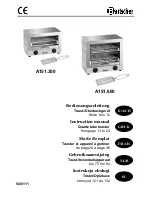
72
6.3.7. TEST OF RESIDUAL CURRENT DEVICE
Quantities of influence
Limits of the range of use
Variation of the measurement
Typical
Maximum
Temperature
-10 … + 55 °C
1 %/10 °C ± 1 ct
2 %/10 °C + 2 ct
Relative humidity
10 … 85 % RH at 45°C
2 %
3 % + 2 ct
Supply voltage
8.4 … 10 V
0.1% or 1 ct
0.5% + 2 ct
Network frequency of the installation
tested
99 to 101% of the nominal
frequency
0.1% or 1 ct
0.1% + 1 ct
Network voltage of the installation tested
85 to 110% of the nominal
voltage
0.1% or 1 ct
0.1% + 1 ct
6.3.8. DIRECTION OF PHASE ROTATION
No quantity of influence
6.4. INTRINSIC UNCERTAINTY AND OPERATING UNCERTAINTY
The C.A 6113 installation tester complies with standard IEC-61557, which requires that the operating uncertainty, called B, be
less than 30%.
In insulation, B = ± ( |A| + 1,15
√
E
1
² + E
2
² + E
3
² )
with
A = intrinsic uncertainty
E
1
= influence of the reference position ± 90°.
E
2
= influence of the supply voltage within the limits indicated by the manufacturer
E
3
= influence of the temperature between 0 and 35°C.
In continuity measurement, B = ± ( |A| + 1,15
√
E
1
² + E
2
² + E
3
² )
In loop measurement, B = ± ( |A| + 1,15
√
E
1
² + E
2
² + E
3
² + E
6
² + E
7
² + E
8
² )
with E
6
= influence of the phase angle from 0 to 18°.
E
7
= influence of the network frequency from 99 to 101% of the nominal frequency.
E
8
= influence of the network voltage from 85 to 110% of the nominal voltage.
In earth measurement, B = ± ( |A| + 1,15
√
E
1
² + E
2
² + E
3
² + E
4
² + E
5
² + E
7
² + E
8
² )
with E
4
= influence of the interference voltage in series mode (3 V at 16.6, 50, 60, and 400 Hz)
E
5
= influence of the resistance of the rods from 0 to 100 x R
A
but
≤
50 k
W
.
In test of residual current device, B = ± ( |A| + 1,15
√
E
1
² + E
2
² + E
3
² + E
5
² + E
8
² )
with E
5
= influence of the resistance of the probes within the limits indicated by the manufacturer.
6.5. POWER SUPPLY
The device is powered by a 9.6 V, 4 Ah rechargeable NiMH battery pack.
6.5.1. NIMH TECHNOLOGY
The NIMH technology has many advantages:
long life between charges with limited bulk and weight,
the possibility of recharging your battery rapidly,
a very small memory effect: you can recharge your battery even if it is not fully discharged, without reducing its capacity,
protection of the environment through the absence of polluting materials such as lead and cadmium.
The NiMH technology allows a limited number of charging/discharging cycles that depends on the conditions of use and the
charging conditions. Under optimum conditions, this number of cycles is 200.











































